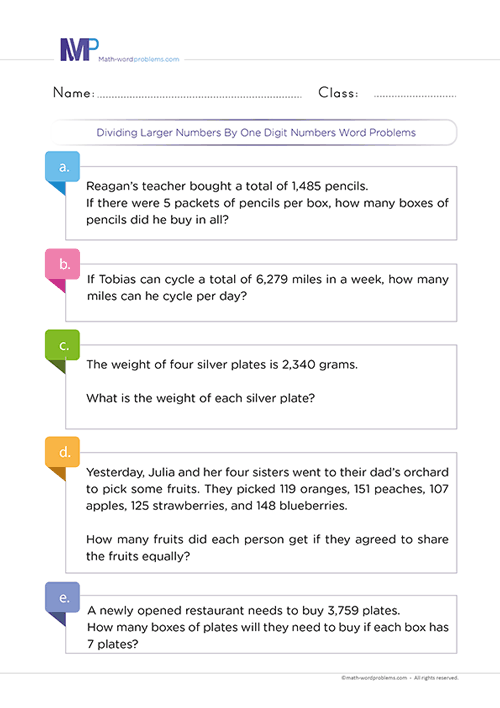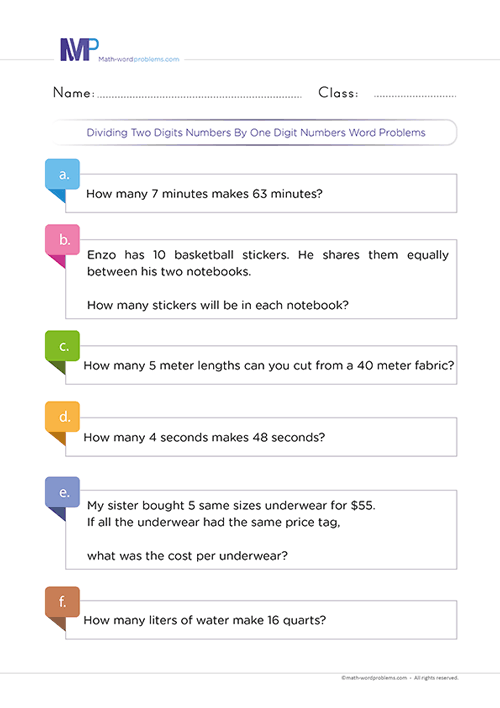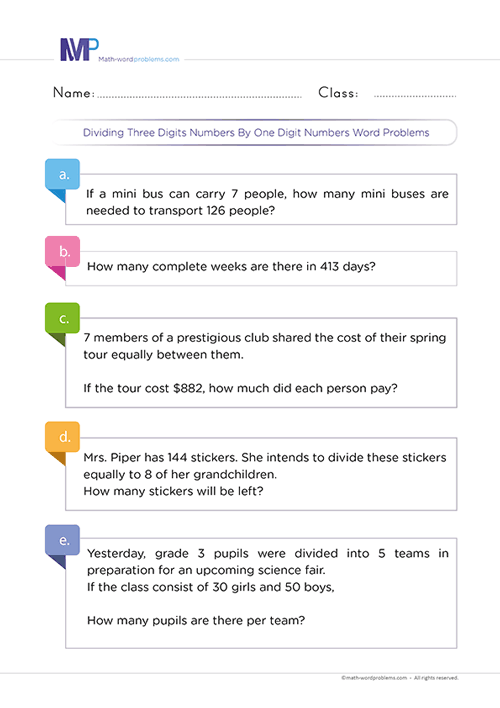 How to divide larger numbers by one-digit number word problems
How to divide larger numbers by one-digit number word problems

- INTRODUCTION
- Step 1 Identify
- Step 2 STRATEGIZE
- Step 3 SET UP
- Step 4 PROVIDE A SOLUTION
- Step 5 CHECK YOUR WORK
Get more contents on this skill...
Find here the best guide with fun tips on how to divide larger numbers by one-digit number word problems. We will present a step-by-step guide wherein, after going through it, kids will quickly understand the read-to-understand rule, thus easily identify the problem, strategize and determine the operation
We believe this understanding will facilitate kids' learning of more advanced mathematical ideas in dividing larger numbers by one-digit number word problems.
In addition, our design will provide the technique 3rd graders need for conceptual understanding and procedural knowledge critical for competence to divide larger numbers.
Steps on how to divide larger numbers by one-digit numbers word problems
This resource consists of outstanding steps on how to divide larger numbers by one-digit number word problems.
As mentioned above, we are designing these steps to ensure that 3rd Graders improve their conceptual understanding of division word problems, an essential building block for successful advancement in elementary mathematics.
So, our unique design will help kids solve challenging problems with these simple steps on how to divide larger numbers by one-digit number word problems. However, we will attach some fun real-life examples to show you how incredible these steps work.
Step 1 IDENTIFY THE PROBLEM
To identify the problem,
- You can start by reading out the problem carefully to understand it.
- Then, identify and underline vital statements that are related.
- Now, reread the problem and try to figure out any important numbers and keywords in the problem.
That is, the keywords that you’ll most likely encounter when you need to perform a division operation are: divide, half, evenly, every, per, parts, out of, the quotient of, the ratio of, how many in each, equal parts, cut up, average, as much, etc.
Note: learners should understand that it would be best not to rely entirely on keywords alone because a particular keyword can have different meanings in different word problems.
In that case, you need to read the question very well to understand the situation the word problem describes. After reading, you will also find out if the problem makes sense first before determining which operation you need to use.
Step 2 STRATEGIZE AND DETERMINE THE OPERATIONS
In this step, ask yourself this pertinent question because it helps, “how am I going to handle this problem?”
Here, you must apply the read-to-understand rule. That is to say, you have to read the word problem and try to interpret it in your own words.
Furthermore, since each word problem may require a different solving format, the key points below will enable you to tackle any word problem irrespective of the format.
- First, the keyword(s) in the word problem will help clarify the operation you need to carry out.
- However, relying on keywords alone to solve word problems has some limits, as mentioned in step 1 above.
- So, you must first read the word problem to understand the situation that the problem is describing.
- Reading the problem to understand it will enable you to identify the problem type and relative statements in the word problem, which, together with the keyword(s) in the problem, will determine the correct maths operation that you need to use
Step 3 SET UP A NUMBER SENTENCE AND AN EQUATION
- Now, after knowing which operation you will perform from step 2 above, construct short sentences to represent the information given in the word problem.
- These short sentences represent the vital information that makes it easier to solve the word problem. In order words, it is like a diagram of the word problem.
- After that, you can now deduce a solvable maths equation to represent the information given in the sentences that you constructed above.
Step 4 SOLVE THE PROBLEM
After writing down the maths equation, divide the values using either the short or the long division method. Also, add the unit of measurement in your final answer.
Step 5 VERIFY YOUR ANSWER
Finally, check your work to make sure that your answer is correct. For instance, since you are dealing with only numbers and not algebraic expressions, it is good to use reasonableness by estimation to see if your answer makes sense.
Therefore, if you estimate and the answer is close to what you have, your answer is correct. However, if your answer is beyond reasonable limits, you must go back to step one and start again.
Examples of how to divide larger numbers by one-digit numbers word problems
Example One
- How many marbles were in each jar?
- How many marbles were in each jar provided one more jar was added to the initial number of jars he had?
Step 1:Read the problem and underline all the relational statements. After reading the problem, you’ll find the important numbers 14,580 and 4. Also, the keyword in the word problem is “equally.”
Step 2:
Now, we have to construct short sentences to represent the given word problem.
The question is, "how will you solve this problem?"
Reread the problem and interpret it in your own words to come out with the correct operation without necessarily depending on the keyword.
The problem says Jude picked a certain number of marbles and shared them equally into a certain number of jars.
Now, the problem wants you to find the number of marbles in each jar.
“which operation can I use to split a large group/part into smaller groups/parts such that every group/part will have an equal number of things?”
For example, in the given problem, the large group you need to split is the number of marbles, and the number of things needed in every group is the equal number of marbles that can go into the given number of jars.
From the situation that the problem is describing, from interpreting the problem in your own words, and from the keyword found in the word problem, it shows that you have to perform a division operation.
Step 3: Construct short sentences representing the most vital information in the word problem.
After that, translate the sentence that is in bold below into an accurate solvable math equation.
- Number of marbles that Jude picked = 14,580,
- Number of jars given = 4,
- Therefore, the number of marbles in each jar = the number of marbles that Jude picked ÷ the number of jars given;
→ 14,580 ÷ 4 = ?
Step 4: From step 3 above, divide the values using either the short or the long-division method. Also, include the unit of measurement in your final answer.
Using the long-division method, we have
So, there were 3,645 marbles in each jar.
Step 5:Finally, check your work to ensure it is correct. Since you are dealing with only numbers and not algebraic expressions, it is good to use reasonableness by estimation to see if your answer makes sense.
So, if you estimate and the answer is close to the one you have, then your answer is correct. However, if your answer is beyond reasonable limits, you must go back to step one and start again.
Example one: solution b
Step 1:Read the problem and underline all the relational statements. After reading the problem, you’ll find the important numbers 14,580 and 4. Also, the keyword in the word problem is “equally “ and “added.”
Step 2:The question is, "how will you solve this problem?"
Reread the problem and retell it in your own words to come out with the correct operation without necessarily depending on the keyword.
The problem is saying Jude picked a certain number of marbles and shared them equally into a certain number of jars.
Now, the problem wants you to find the number of marbles in each jar.
Now, “which operation can I use to split a large group/part into smaller groups/parts such that every group/part will have an equal number of things?”
For example, in the given problem, the large group you need to split is the number of marbles, and the number of things needed in every group is the equal number of marbles that can go into the given number of jars.
So, from the situation that the problem is describing, from interpreting the problem in your own words, and from the keyword found in the word problem, it shows that you have to perform a division operation.
But if you reread the question, you’ll find out the number of jars has changed. The question says, “one more jar was added.” So, expect to perform an addition operation at some point,
Step 3: Construct short sentences representing the most vital information in the word problem.
After that, translate the sentence that is in bold below into an accurate solvable math equation.
- Number of marbles that he picked = 14,580,
- Number of jars = 4,
- Number of jars added to the initial jars = 1,
- The total number of jars now = 4 + 1 = 5,
- Therefore, the number of marbles in each jar = the number of marbles he picked ÷ the total number of jars now;
→ 14,580 ÷ 5 = ?
Step 4:From step 3 above, divide the values using either the short or the long-division method. Also, add the unit of measurement to your final answer.
Using Using the long-division method, we have
So, 2,916 marbles were in each jar
Step 5:Finally, check your work to ensure your answer is correct. Since you are dealing with only numbers and not algebraic expressions, it is good to use reasonableness by estimation to see if your answer makes sense.
So, if you estimate and the answer is close to the one you have, then your answer is correct. However, if your answer is beyond reasonable limits, you must go back to step one and start again.





